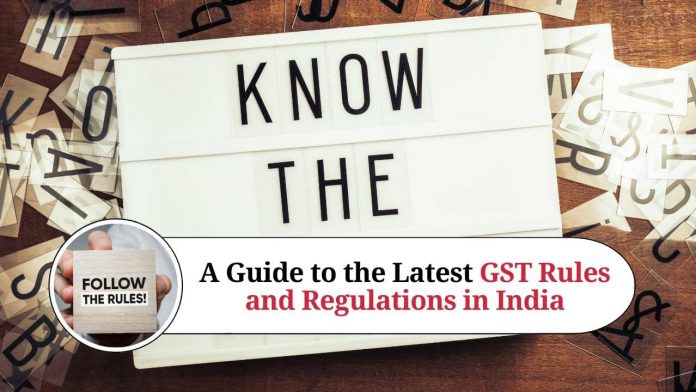Introduction
The Goods and Services Tax (GST) is a comprehensive indirect tax levied on the manufacture, sale, and consumption of goods and services in India. The GST system was introduced on July 1, 2017, as a unified tax regime replacing various indirect taxes, including value-added tax, central excise duty, and service tax. Since its inception, the GST regime has undergone several changes to make it more comprehensive, taxpayer-friendly, and administratively simpler. In this blog, we will discuss the latest GST rules and regulations that were introduced in January 2023.
Increase in GST Composition Scheme Threshold Limit
The GST composition scheme is a scheme for small taxpayers with an annual turnover of up to Rs. 2 crore. Under this scheme, taxpayers are required to pay a simplified tax rate of 6% on the turnover without the right to input tax credit. The GST Council has increased the threshold limit for the GST composition scheme from Rs. 2 crore to Rs. 5 crore, providing relief to small businesses and traders.
Changes in the GST Return Filing Process
The GST Council has introduced a new simplified return filing system, known as the GST Annual Return, for taxpayers with an annual turnover of up to Rs 5 crore. This return will replace the current GST returns (GSTR-3B and GSTR-1) and will be a simplified, one-page form that can be filed annually. The new return form will have only a few fields, including turnover, GST liability, and input tax credit.
Introduction of GST E-Invoicing
GST e-invoicing is a new system for generating invoices and transmitting them to the GST portal. The e-invoicing system will help reduce the compliance burden for businesses and improve the accuracy of invoices. The e-invoicing system will be mandatory for businesses with a turnover of Rs. 100 crore and above, while businesses with a turnover of up to Rs. 100 crore can opt for it voluntarily.
Changes in the GST Input Tax Credit System
The GST Council has introduced several changes in the input tax credit system to reduce the compliance burden on businesses. The changes include the removal of the requirement to match invoices before claiming input tax credit, the introduction of a provisional input tax credit mechanism, and the introduction of a simplified form for the reversal of input tax credit.
Extension of GST Audit Time Limit
The GST Council has extended the time limit for conducting the GST audit from September 30 to December 31. This extension will provide businesses with additional time to complete the audit process and avoid penalties for late filing.
Expansion of the GST e-way bill system
The e-way bill system under GST is an electronic document that is required for the movement of goods worth more than Rs. 50,000. The GST Council has expanded the e-way bill system to include inter-state movements of goods by railways, airways, and vessels. This expansion will help reduce the compliance burden for businesses and improve the efficiency of the transportation of goods.
Relaxation of GST Compliance Requirements for MSMEs
Micro, Small, and Medium Enterprises (MSMEs) play a crucial role in the Indian economy, and the GST Council has taken several steps to simplify the GST compliance process for them. The Council has relaxed the compliance requirements for MSMEs, including the extension of the GST return filing due date and the introduction of a simplified GST return form.
Introduction of the GST Refund Process
The GST Council has introduced a simplified GST refund process to reduce the compliance burden on businesses and improve the efficiency of the refund process. The new process includes the introduction of an electronic refund module, the simplification of the refund application form, and the expedited processing of refund claims.
Implementation of the GST, TDS, and TCS Provisions
The GST TDS (Tax Deducted at Source) and TCS (Tax Collected at Source) provisions were introduced to improve the efficiency of tax collection and ensure the timely payment of taxes. The provisions require taxpayers to deduct or collect tax at the source and deposit it with the government. The implementation of the TDS and TCS provisions will help reduce tax evasion and improve tax compliance.
Changes in the GST Tax Rates
The GST Council periodically reviews the GST tax rates and makes changes as required. The latest GST rates include a reduction of the GST rate on several goods and services, including electric vehicles, mobile phones, and restaurants. The reduction of GST rates will reduce the cost of these goods and services and make them more affordable for consumers.
Conclusion
In conclusion, the latest GST rules and regulations aim to simplify the GST compliance process, reduce the administrative burden on businesses, and improve the efficiency of the tax collection process. The GST regime is constantly evolving to meet the needs of the Indian economy and businesses, and the latest rules and regulations are a step in the right direction.
Read more useful content:
Frequently Asked Questions (FAQs)
Q1. What is the GST Composition Scheme?
A: The GST Composition Scheme is a simplified tax regime for small taxpayers with an annual turnover of up to Rs 5 crore. Under this scheme, taxpayers are required to pay a simplified tax rate of 6% on their turnover without the right to input tax credit.
Q2. What is the GST Annual Return?
A: The GST Annual Return is a simplified return form introduced by the GST Council for taxpayers with an annual turnover of up to Rs 5 crore. The return form is a one-page form that can be filed annually and replaces the current GST returns (GSTR-3B and GSTR-1).
Q3. What is GST E-Invoicing?
A: GST E-Invoicing is a system for generating invoices and transmitting them to the GST portal. The e-invoicing system is aimed at reducing the compliance burden for businesses and improving the accuracy of invoices. The e-invoicing system is mandatory for businesses with a turnover of Rs. 100 crore and above and can be opted for voluntarily by businesses with a turnover of up to Rs. 100 crore.
Q4. What are the changes in the GST Input Tax Credit System?
A: The GST Council has introduced several changes in the input tax credit system to reduce the compliance burden on businesses. These changes include the removal of the requirement to match invoices before claiming an input tax credit, the introduction of a provisional input tax credit mechanism, and the introduction of a simplified form for the reversal of an input tax credit.
Q5. What is the GST E-Way Bill system?
A: The GST E-Way Bill system is an electronic document that is required for the movement of goods worth more than Rs. 50,000. The e-way bill system has been expanded to include inter-state movements of goods by railways, airways, and vessels.
Q6. What are the GST, TDS, and TCS provisions?
A: The GST TDS (Tax Deducted at Source) and TCS (Tax Collected at Source) provisions require taxpayers to deduct or collect tax at the source and deposit it with the government. The implementation of the TDS and TCS provisions is aimed at reducing tax evasion and improving tax compliance.
Q7. What is the GST Refund Process?
A: The GST Refund Process is a simplified process for claiming GST refunds. The new process includes the introduction of an electronic refund module, the simplification of the refund application form, and the expedited processing of refund claims.
Q8. What is the GST rate on electric vehicles?
A: The GST rate on electric vehicles has been reduced from 12% to 5%. This reduction in the GST rate will make electric vehicles more affordable for consumers.
Q9. What is the due date for filing GST returns for MSMEs?
A: The GST Council has relaxed the compliance requirements for Micro, Small, and Medium Enterprises (MSMEs) and extended the due date for filing GST returns. The exact due date for filing GST returns for MSMEs will depend on their turnover and other factors.




















